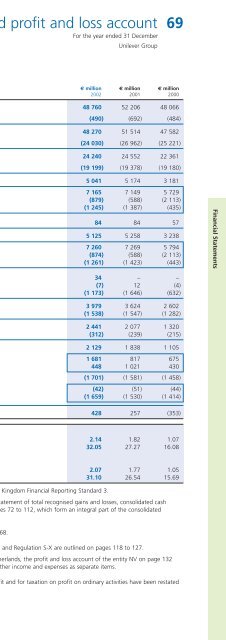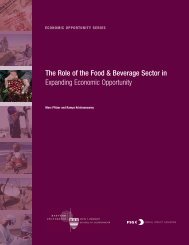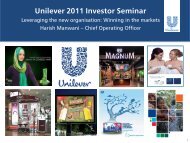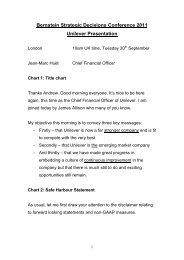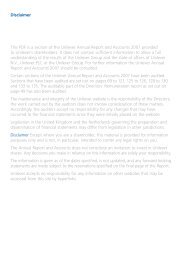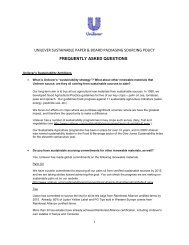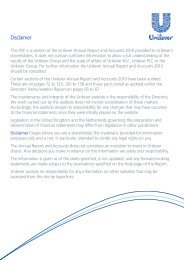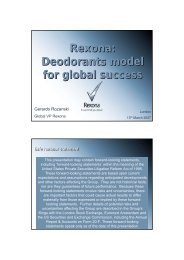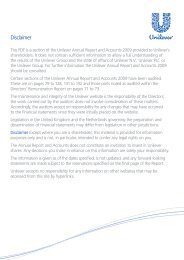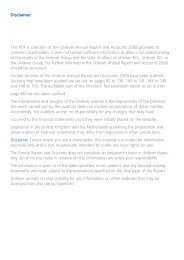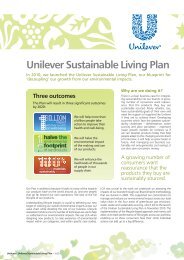Report & accounts 2002 in full - Unilever
Report & accounts 2002 in full - Unilever
Report & accounts 2002 in full - Unilever
Create successful ePaper yourself
Turn your PDF publications into a flip-book with our unique Google optimized e-Paper software.
140 Control of <strong>Unilever</strong><br />
If you are a holder of NV New York shares or PLC American<br />
Depository Receipts of shares, you will receive a proxy form<br />
enabl<strong>in</strong>g you to authorise and <strong>in</strong>struct ABN AMRO N.V. or<br />
JPMorgan Chase Bank respectively to vote on your behalf<br />
at the shareholders’ meet<strong>in</strong>g of NV or PLC.<br />
Resolutions are usually adopted at NV and PLC shareholder<br />
meet<strong>in</strong>gs by an absolute majority of votes cast, unless there<br />
are other requirements under the law or the NV or PLC<br />
Articles. There are special requirements for resolutions<br />
relat<strong>in</strong>g to the alteration of NV or PLC’s Articles of<br />
Association or the Equalisation Agreement, or to the<br />
liquidation of NV or PLC.<br />
Accord<strong>in</strong>g to NV’s Articles, shareholders who together<br />
represent at least 10% of the issued capital of NV can<br />
propose resolutions for <strong>in</strong>clusion <strong>in</strong> the agenda of any<br />
General Meet<strong>in</strong>g. They can also requisition Extraord<strong>in</strong>ary<br />
General Meet<strong>in</strong>gs to deal with specific resolutions. However,<br />
follow<strong>in</strong>g the recommendations of the Committee of<br />
Corporate Governance, the board of directors has confirmed<br />
that shareholders may propose resolutions if:<br />
• they <strong>in</strong>dividually or together hold 1% of the issued<br />
capital; or<br />
• they hold shares or depository receipts worth at least<br />
€226 890.<br />
They must submit the request at least 60 days before the<br />
date of the General Meet<strong>in</strong>g, and it will be honoured unless,<br />
<strong>in</strong> the op<strong>in</strong>ion of the Board of Directors, it is aga<strong>in</strong>st the<br />
<strong>in</strong>terests of the company.<br />
Under United K<strong>in</strong>gdom company law,<br />
• shareholders who together hold shares represent<strong>in</strong>g<br />
at least 5% of the total vot<strong>in</strong>g rights of PLC; or<br />
• at least 100 shareholders who hold on average<br />
£100 each <strong>in</strong> nom<strong>in</strong>al value of PLC capital<br />
can require PLC to propose a resolution at a<br />
General Meet<strong>in</strong>g.<br />
There are no limitations on the right to hold NV and<br />
PLC shares.<br />
Directors<br />
The directors of NV are able to vote on transactions <strong>in</strong> which<br />
they are materially <strong>in</strong>terested so long as they are act<strong>in</strong>g <strong>in</strong><br />
good faith. In general PLC directors cannot vote <strong>in</strong> respect<br />
of contracts <strong>in</strong> which they know they are materially<br />
<strong>in</strong>terested, unless, for example, their <strong>in</strong>terest is shared with<br />
other shareholders and employees.<br />
The borrow<strong>in</strong>g powers of NV directors are not limited by<br />
the Articles of Association of NV. PLC directors have the<br />
power to borrow up to three times the Adjusted Capital<br />
and Reserves of PLC without the sanction of an<br />
ord<strong>in</strong>ary resolution.<br />
<strong>Unilever</strong> Annual <strong>Report</strong> & Accounts and Form 20-F <strong>2002</strong><br />
The Articles of Association of NV and PLC do not require<br />
directors of NV, or <strong>full</strong>-time employed directors of PLC, to<br />
hold shares <strong>in</strong> NV or PLC. Directors of PLC who are not<br />
employed <strong>full</strong>-time by NV or PLC must hold either £1 000<br />
<strong>in</strong> nom<strong>in</strong>al value of PLC ord<strong>in</strong>ary shares, or €5 445 <strong>in</strong><br />
nom<strong>in</strong>al value of NV ord<strong>in</strong>ary shares. The remuneration<br />
arrangements applicable to directors as employees conta<strong>in</strong><br />
requirements for the hold<strong>in</strong>g and retention of shares (see<br />
Remuneration report on page 55).<br />
Mutual guarantee of borrow<strong>in</strong>gs<br />
There is a contractual arrangement between NV and PLC<br />
under which each will, if asked by the other, guarantee the<br />
borrow<strong>in</strong>gs of the other. They can also agree jo<strong>in</strong>tly to<br />
guarantee the borrow<strong>in</strong>gs of their subsidiaries. We use this<br />
arrangement, as a matter of f<strong>in</strong>ancial policy, for certa<strong>in</strong><br />
significant public borrow<strong>in</strong>gs. The arrangements enable<br />
lenders to rely on our comb<strong>in</strong>ed f<strong>in</strong>ancial strength.<br />
Comb<strong>in</strong>ed earn<strong>in</strong>gs per share<br />
Because of the Equalisation Agreement and the other<br />
arrangements between NV and PLC we calculate comb<strong>in</strong>ed<br />
earn<strong>in</strong>gs per share for NV and PLC (see note 7 on pages 79<br />
and 80).<br />
We base the calculation on the average amount of NV and<br />
PLC’s ord<strong>in</strong>ary capital <strong>in</strong> issue dur<strong>in</strong>g the year. For the ma<strong>in</strong><br />
calculation we exclude shares which have been purchased<br />
to satisfy employee share options. We also calculate a<br />
diluted earn<strong>in</strong>gs per share figure, where we <strong>in</strong>clude these<br />
shares, as well as certa<strong>in</strong> PLC shares which may be issued<br />
<strong>in</strong> 2038 under the arrangements for the variation of the<br />
Leverhulme Trust (see below).<br />
The process by which we calculate earn<strong>in</strong>gs per share<br />
is as follows. First we convert the average capital of NV<br />
and PLC <strong>in</strong>to units us<strong>in</strong>g the formula conta<strong>in</strong>ed <strong>in</strong> the<br />
Equalisation Agreement: one unit equals 10.7 NV shares<br />
or 71.4 PLC shares. We add these together to f<strong>in</strong>d the total<br />
number of units of comb<strong>in</strong>ed share capital. Then the amount<br />
of net profit <strong>in</strong> euros which is attributable to ord<strong>in</strong>ary capital<br />
is divided by this total number of units to f<strong>in</strong>d the amount<br />
per comb<strong>in</strong>ed unit. F<strong>in</strong>ally we convert the comb<strong>in</strong>ed unit<br />
back <strong>in</strong>to NV and PLC ord<strong>in</strong>ary shares, to show the amount<br />
per one share of each. The amount per unit is divided by<br />
10.7 to f<strong>in</strong>d the amount per €0.51 share, and by 71.4 to<br />
f<strong>in</strong>d the amount per 1.4p share.<br />
Despite the Equalisation Agreement, NV and PLC are<br />
<strong>in</strong>dependent corporations, and are subject to different<br />
laws and regulations govern<strong>in</strong>g dividend payments <strong>in</strong> the<br />
Netherlands and the United K<strong>in</strong>gdom. We assume <strong>in</strong><br />
our comb<strong>in</strong>ed earn<strong>in</strong>gs per share calculation that both<br />
companies will be able to pay their dividends out of their<br />
part of our profits. This has always been the case <strong>in</strong> the<br />
past, but if we did have to make a payment from one to<br />
the other it could result <strong>in</strong> additional taxes, and reduce<br />
our comb<strong>in</strong>ed earn<strong>in</strong>gs per share.


